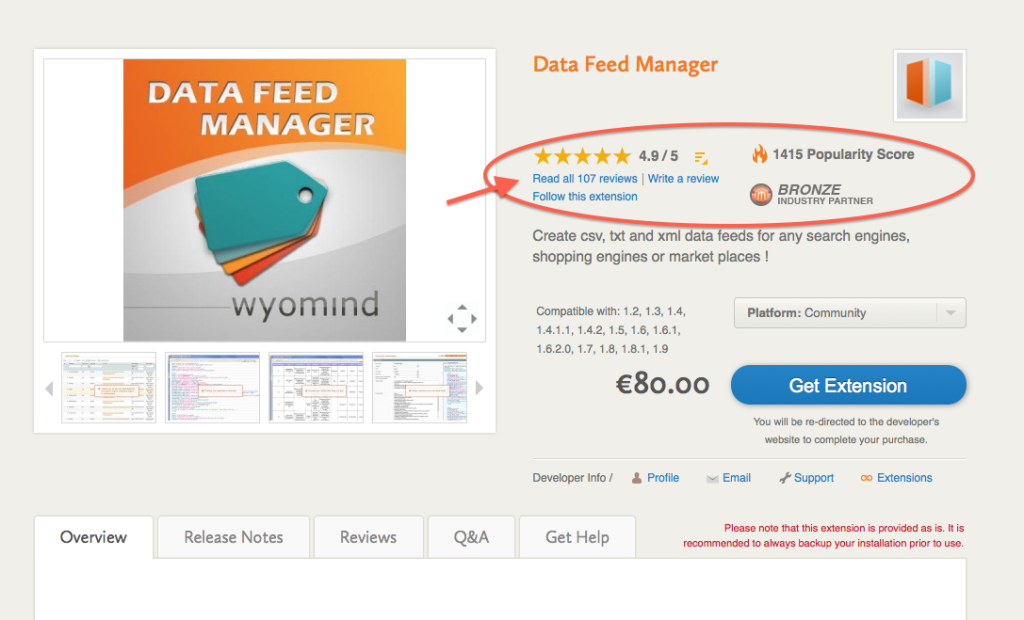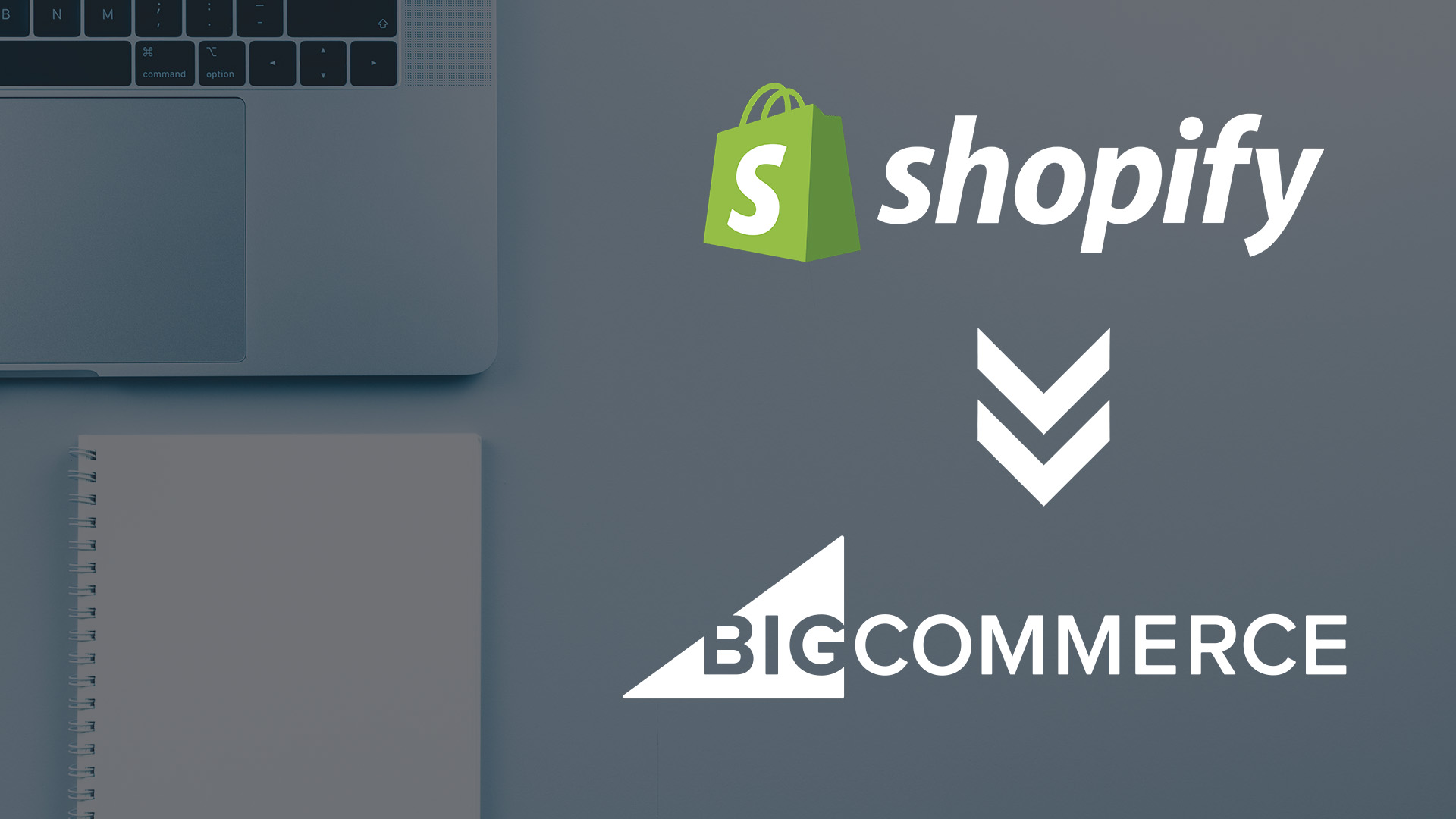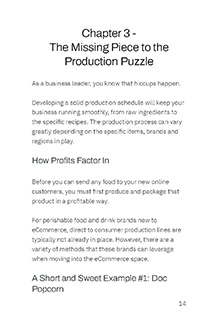Introduction
Introducing eCommerce Food Trends
Picture this. You have a long day of work ahead, and you’re craving coffee.
To stick with your routine, you swing by your favorite coffee shop in Seattle.
The slight problem? You moved to Los Angeles last week, and the commute would be just a little too long. Understandable.
Never one to ignore a caffeine fix, you find a new go-to spot. Better yet, they sell their beans online so you can make their coffee at home too.
Moral of the story? Don’t give your customers an opportunity to find a competitor.
If you want to keep your customer’s close, and expand your customer base beyond locals and tourists, you’re going to need to think bigger about your product’s potential.
In recent years, consumer interest in ordering perishable goods through the internet has exponentially increased, which means it’s the perfect
time to try it out. As eCommerce becomes mainstream in this vertical, merchants like you have a unique opportunity to capitalize on increased demand.
But before you capitalize, you’ll need to strategize.
That’s why we put together this handy guide to learn how to safely sell your perishable products online so your customers can enjoy your products on their terms.
To sweeten the deal, we used Dippin’ Dots as our shining client example of how selling food online can be a huge benefit for your brand. Never heard of these bite-size pieces of magic? Dippin’ Dots serves tiny nitrogen-frozen ice cream “dots” to consumers at theme parks, entertainment venues and brick-and-mortar stores across the United States.
In this ebook, we’ll explore:
- The advantages of selling online
- Which legal licenses you need to secure
- The right eCommerce platform to pick
- How to set up your production, storage and shipping processes
- Strategies to develop a strong brand presence
Chapter 1
Should Your Business Be Online?
What Kind Of Foods Sell Best Online?
No matter if your business is big or small, every decision must be made thoughtfully. If you’re hesitant about selling beyond your physical locations, we get it.
Here are a few reasons why you should consider giving your delicious product lines a digital presence.
Build Brand Awareness
The foremost reason why brand-new customers won’t purchase your food and beverage products is simply put; that they don’t know about them!
You may currently offer your product in select locations limited by big-box store shelf space or geographical location. Even after leveraging geographically-based advertising, your target audience is extremely small relative to the total number of potential customers who are willing to try products they find online.
Online advertising in conjunction with a stunning eCommerce site equips merchants with a wide net that can capture new first-time customers. Brands can then assess new geographic market opportunities to offer their products in-store.
Quick Tip:
By offering your perishable products directly to consumers outside of your existing in-person sales channels, you can retain your loyal customers while earning new brand champions without sacrificing profit margins to middle-men and chain grocery stores.
Connect with Your Fans From Afar
Don’t let long-distance ruin a good relationship.
The second largest sales barrier for brands that only sell in-store is a potential customer’s distance from a retail location that carries the product.
Whether a customer falls in love with your product on vacation or you move your storefront to another location, you want to create more access points for your customer, not less.
Quick Tip:
With an accessible online platform, a customer willing to pay the associated costs will be able to enjoy it from the comfort of their home all year long.
Be the Life of the Party
Throughout the year, your customers are likely celebrating a few events between holidays and birthdays.
Without a direct-to-consumer eCommerce channel, this potential large-order customer would be forced to purchase all of the products they would like at a physical location
And for party-planning efficiency, easy-to-make snacks, like frozen appetizers or sweet treats like ice cream sandwiches will definitely make the grocery store list.
Even if this action is taken, the customer would then need to find a way to keep these treats frozen until it is time to serve them. For most households in the United States and across the world, a spare freezer is not available. To overcome this, the purchasing customer could leverage a large cooler - which could work for 6-8 hours in a best-case scenario.
Quick Tip:
By offering your products online, consumers can buy the full quantity they would like to be delivered on the exact day (or the day before) that they need it. The less work you can create for your customer, the more likely they will keep coming back. In Chapter 6, we’ll discuss how to set up an online delivery date selection calendar.
The Bottom Line:
If it makes sense with your future business goals to grow online, give it a try. The upfront investment will be worth it if you have a good product, loyal customers, and a solid plan for paid advertising.
Chapter 2
Back to Basics:
What You’ll Need to Start Selling
If you’re ready to get your business up and running online, you’ll need to take a few simple steps before you get started.
Repeat after us: safety first, success second.
Meeting your Standard Requirements
Whether online or in-person, selling food comes with a laundry list of rules and regulations. Before we address the eCommerce-specific requirements, let's discuss the criteria that all food retailers must comply with.
Please note that this blog post is not legal advice, and you should work with appropriate counsel to ensure regulatory compliance.
Standard Business License
In order to accept transactions of any type, food or not, you will need to register your business with the appropriate government agencies.
County, State & Country Permits
Each locality can have its own governing body for both food manufacturers and retailers. At a bare minimum, you will need to apply for the correct license in your state.
Becoming A Certified Food Handler
While becoming a certified food handler is not a requirement in every state, it is highly recommended. In the process of obtaining this certification, you will learn about food safety practices, cooking temperatures, foodborne illnesses and more.
Additional Certifications To Build Consumer Confidence
The more valuable (ISO-recognized) certificates you and your business hold, the more potential customers will trust the safety of your products. It is recommended to find certifications relevant to your products and customer base.
Food Labels
Due to the Fair Packaging and Labeling Act, all food retailers must display clear signage that lists any common allergens that could be in any of the food products being served. Common allergens include milk, eggs, nuts, fish, shellfish, soy, and wheat. It is also required that you state ingredients, calories, servings per container and all other federally-required information.
Choosing the Right eCommerce Platform
No pressure, but what’s your five year business plan?
If you’re heading online, the eCommerce platform you chose will often determine how you will run and grow for the next few years. So, we’re writing you a permission slip to be picky with your platform.
For food and drink retailers with an existing physical presence, the seriousness of this decision is two-fold. Not only will online customers be interacting with your site, but fans of your physical locations will as well.
It is impossible to list all of the different challenges
that each specific merchant could face with a given platform. These could range from particular selling features being completely unavailable to necessary custom integrations not being supported.
Whatever the needs of your individual company, you will need to make sure that the platform you choose has the feature set and custom-development abilities required for success.
When considering eCommerce platforms, you have a vast number of options to choose from. Through our 15+ years of experience, we have determined that SaaS solutions best fit the needs of most merchants. Within the bucket of SaaS eCommerce solutions, we have determined two key players that can be adapted to solve the challenges that perishable food and drink merchants face.
Option 1: BigCommerce
This platform has grown to be one of the top contenders in the eCommerce ecosystem. This platform comes out of the box with everything you need to get your online store up and running. With hundreds of integrations to improve your website, you can bolster your store with any features or functionality you see fit. We have written countless articles on this platform, and as platinum
BigCommerce partners, we are a premier agency for creating special online experiences for your customers.
Some eCommerce platforms are larger than others in terms of the number of individual merchants that host their stores there. In the case of food & perishable brands, we believe that BigCommerce is the best solution on the market.
Whether your brand requires quantity discounts, membership discounts, shipping integrations, marketing integrations, or custom development, BigCommerce can do it all.
Option 2: Shopify
Shopify is the most widely used eCommerce platform on the market at the time of writing this blog. While Shopify’s digital advertising takes aim at startups and entrepreneurs, this platform is no slouch for
mid-market and enterprise brands. Much like BigCommerce, Shopify offers a massive library of integrations, which they call apps. We are also a Shopify partner agency, having built and maintained eCommerce stores for leading brands.
One Last Thing: A Quick Note about Technical Debt
In short, with SaaS eCommerce platforms, all of the technical debt historically associated with hosting an online store is essentially reduced to 0. With an on-premise hosted eCommerce store, general upkeep, server maintenance, and security updates are all handled by a paid systems administrator. With the solutions listed above, none of these concerns apply.
The Bottom Line:
If it makes sense with your future business goals to grow online, give it a try. The upfront investment will be worth it if you have a good product, loyal customers, and a solid plan for paid advertising.
Chapter 3
The Missing Piece to the Production Puzzle
Food Production & eCommerce
As a business leader, you know that hiccups happen.
Developing a solid production schedule will keep your business running smoothly, from raw ingredients to the specific recipes. The production process can vary greatly depending on the specific items, brands and regions in play.
How Profits Factor In
Before you can send any food to your new online customers, you must first produce and package that product in a profitable way.
For perishable food and drink brands new to eCommerce, direct to consumer production lines are typically not already in place. However, there are a variety of methods that these brands can leverage when moving into the eCommerce space.
A Short and Sweet Example #1: Doc Popcorn
Doc Popcorn is a sister brand of Dippin’ Dots that offers delicious gourmet popcorn. This brand pops its product fresh at its brick-and-mortar franchise locations to serve customers. Franchisees order seasonings, oils, raw popcorn kernels and all other materials as needed.
When we designed and developed this client’s new website on BigCommerce, we collectively needed to decide the best purchasing and production workflow for eCommerce customers.
One option was to offer the materials unprepared directly to consumers. Although some customers may have the equipment and technical know-how to prepare the product correctly, in the case of this client, most would not.
This would likely lead to ruined products and unhappy customers. In short, Doc Popcorn would have no quality control over its products.
The second more costly option would be to centralize production of both franchisee orders and eCommerce orders under the same roof. Unfortunately in the case of this retailer, their current facility could not accommodate this level of production. Doc Popcorn would need to build an entirely new facility which would be both time and cost-prohibitive.
Ultimately, this client decided to take another route.
The Solution
To combat these issues, Doc Popcorn created a plan for the franchised location closest to each customer to prepare and ship orders themselves. This solution allowed the client to maintain their existing production workflow, while providing additional revenue to franchisees.
The Bottom Line
The recipe you’ve perfected is precious. Plan your production process in a way that minimizes cost and product waste, but still keeps quality control in place.
Chapter 4
Setting Your Storage Up for Success
Cold Storage & Food Expiration
If you’ve been in the food business for a bit, we don’t need to tell you twice that proper storage is critical to keeping products fresh.
Common Storage Issues
Product storage is where many brands lose a sizable percentage of their profit margins.
However, storage is an overhead cost that is simply a part of selling products online. For years, brands have tried to implement “just-in-time logistics” to keep inventory overhead as low as possible.
Almost all food and beverage products will go bad if left in a non-climate-controlled environment for a long enough period of time. On the other end of the spectrum, some food products are sure to spoil in a matter of hours if not stored and shipped properly.
In the case of food and drink brands, this importance is magnified. Not only is there a cost associated with storing the product, but it must also be kept in a climate-controlled environment.
On top of that, if the product is stored for too long, it will expire and become a sunk cost, which then takes additional capital to dispose of properly.
A Short and Sweet Example #2: Dippin’ Dots
To store Dippin’ Dots, its container must be kept at sub-freezing temperatures only achievable either through a specialty freezer or frozen CO₂, also known as dry ice.
To store mass amounts of sub-frozen products is extremely cost-prohibitive. This means that for the product to sell online profitably, it would have to be produced and shipped within a very short amount of time.
Here’s the Solution
Dippin’ Dots now leverages the exact same production line for eCommerce purchases that they do for orders from their franchisees. This means that no additional production lines will need to be implemented in order to get this historically franchised product directly to consumers.
Quick Safety Measures
Because you’d rather be safe than have to say “sorry I melted this vanilla cookie dough ice cream on your birthday”.
Universally Recognized Stickers
When shipping perishable food items, ensuring that they do not arrive damaged is key to avoiding unhappy customers and refund requests. A cheap and easy way to reduce the total amount of damaged packages is to use “Fragile,” “This Side Up” and “Perishable” shipping stickers on the outside of boxes. Although all logistics employees do not pay these stickers the respect they should, they are a helpful start.
Dry Ice / Freezer Packs
The number-one most important element of selling perishable goods online is that they arrive unperished. This means that you will need to determine the required internal temperature of your food items, as well as the time period they will need to remain at that temperature.
Once you collect this information, you can begin to choose the shipping materials that your team will use to properly package your sold items. Typically, cooling mediums such as dry ice, freezer packs or cooling packs can regulate the temperature inside the box.
The Bottom Line:
Know your product, and know how long it can last in all temperatures and environments before spoiling. Then, invest in proper storage and the right production partner (see Chapter 3).
Chapter 5
The Simple Science of Shipping
eCommerce Food & Shipping
The final part of your product’s journey is arguably the most important. As a customer anticipates their product, you never want to let them down with delays or missing packages.
We have a complete blog on selling & shipping food online that dives deep into the subject, but for now, let’s look at an overview of shipping, from “add to cart” to the package arriving at the front door.
Setting the Shipping Scene
When shipping food items, speed is the name of the game.
Customers of these products often require a specific delivery date for cookouts, parties or other events.
They may want all items to arrive the day before the get-together will be taking place.
For items that must be kept at a safe internal temperature, such as frozen food or dairy products, be sure to default to two-day shipping. It is smart to enable customers to select one-day shipping if they choose to.
For products that stay fresh for longer periods of time without temperature constraints, it is safe to offer a cheaper 3-5 day shipping option if you are so inclined.
Shipping Costs
Everybody who sells products of any kind online understands that a large percentage of the total price of a product is accounted for in shipping. Shipping costs include labor, packing materials and postage.
A Short and Sweet Example #3: Dippin’ Dots
Dippin’ Dots products must be shipped, received and temperature stabilized to sub-freezing levels within 48 hours to ensure the product is not melted before consumption. If the product is melted, liability rests with the manufacturer to either provide a replacement or a refund.
This brand had to consider the shipping cost of its products. However, charging too high of a price had the potential to dissuade shoppers from purchasing.
Here’s the Solution:
Although dry ice is used, the package must still be stored or consumed by the customer a maximum of 48 hours after being shipped. To guarantee this, our team implemented a delivery date selection calendar directly into BigCommerce’s one-page checkout.
However, shipping methods such as those listed above do not make economic sense if a customer were to only buy a single serving. Because Dippin’ Dots had elected to only sell their products to online customers in 30-serving increments, the high cost of shipping is effectively divided by 30. Each shipment
also includes the necessary disposable cups to recreate an authentic Dippin’ Dots experience.
Instead of creating an entirely new production line just for eCommerce shoppers, these bulk bags are the same bags sent to customers along with 30 serving cups. In the case of Dippin’ Dots, this allows for the cost of shipping and packaging to be evenly spread over many servings, which enables customers to afford the purchase.
eCommerce Shipping Integrations
To make the shipping process seamless, here are a few products we know, love and highly recommend.
Advanced Shipping Manager + Shipstation: Reduce the amount of time that shipping processes take on the warehouse side. By automating label printing and developing custom shipping rules, you can get more packages out of the door faster - leaving more time and resources for other areas of your business.
Shipper HQ: Determine standardized shipping options that correlate to the average order size of their
in-store customers. These standardized shipping materials then get shipped via 2-day mail (you can additionally offer 1-day or same-day delivery if needed) to ensure the products stay fresh and retain the required internal temperature.
The Bottom Line:
Shipping is what will make or break the customer experience - or their hearts. Implementing standardized shipping methods will not only reduce shipping material costs but will require fewer freezing and/or cooling packs due to the reduced transit time.
Chapter 6
Save the Date
How to Create a Custom Delivery Calendar
As mentioned in Chapter 5, timing is everything for the shipping process. We find that a delivery date picker is a key integration for your consumers. Don’t leave your customer wondering when their shipment will come in, especially if they are depending on your product for a party, gift, or weeknight meal.
A delivery date picker is exactly what it sounds like - a widget or embedded piece of content that allows customers to specify the exact date that they would like their products to arrive.
In the past, customers have been able to manually calculate when their package will arrive by subtracting the number of days that their selected shipping method will take from the date they would like the product to show up on their doorstep.
In previous implementations, our team built delivery date selection calendars on the cart page, as opposed to the checkout page. While this implementation does get the job done, both legacy solutions inherently came with added friction in the customer’s journey.
eCommerce merchants should strive to make purchasing as painless as possible. That’s exactly why our team built a custom delivery date selection calendar that is embedded directly into BigCommerce’s signature one-page checkout.
How We Developed The Custom Delivery Date Picker
Advanced Shipping Manager Functionality
As mentioned in Chapter 5, Advanced Shipping Manager is a native BigCommerce integration that allows merchants to define and implement a plethora of unique shipping rules and features for their eCommerce stores. Leveraging Advanced Shipping Manager’s API, our team of designers and developers built a custom shipping and delivery date calendar directly into BigCommerce’s one-page checkout.
BigCommerce One-Page Checkout
Using a one-page checkout has proven to be one of the most effective ways of raising eCommerce conversion rates. A one-page checkout system refers to the fact that instead of a long multi-page checkout process, the entirety of the information required is all on one page.
By implementing this date selection functionality directly into BigCommerce’s one-page checkout, a frictionless customer experience is offered, which leads to higher conversion rates.
Groove Commerce Development
Our team of designers and developers took the functionality that both of these services offer and combined them into a beautiful calendar widget that can match any brand’s style guide to provide a unified experience.
As with all of our website design and development projects, we create custom templates across all customer-facing pages. In cases where our client would like a delivery date selection calendar implemented, we must additionally modify BigCommerce’s one-page checkout template.
This calendar pulls merchant-defined shipping rules from Advanced Shipping Manager and displays them in an intuitive manner that any website visitor will understand instantly.
Once ready to check out, a customer reviews their cart and ensures that the products listed are the ones they would like to purchase. This is exactly how all eCommerce sites have worked for the past decade.
Where things change however is once they click the “checkout” button on the cart screen. They are brought to a single page that requests all of the information that is needed to complete the transaction. One of the first things that this page will ask for from the customer is their desired delivery date. Instead of needing to type in a date in MM/DD/YYYY format, the user can simply click the date on a visually displayed calendar on the screen. This calendar will gray out any dates on which the product can not be delivered. It will also display the associated cost of shipping for each potential delivery date.
The Bottom Line:
Take advantage of the calendar tools you have access to, and if they don’t exist yet, we can help you build one that makes sense for your perishable products.
Chapter 7
How to Create a Memorable Customer Experience
Have Customers Coming Back For Your Online Food Products
When selling food in person, there are so many personal touchpoints that are easy to elevate in a physical store location. With an online store, it can be challenging to recreate that personal experience.
But, it’s not impossible. With the right design and copy, you can make the customer feel your brand personality online, and at their doorstep. Here’s how to create the magic online:
Perfecting the Presentation
One area that can be overlooked is the product presentation once the delivered package is opened.
The presentation of your product will depend entirely on what the product is, your desired profit margin, and your brand’s visual identity. Take time to consider your options and choose one that makes sense for your business.
In addition to a cooling element, perishable
shipments should include a protective layer of styrofoam or packing peanuts. To elevate this presentation, consider encasing all of your products and shipping materials in a branded exterior box. By ensuring that each step of the unboxing experience is centered around the customer, they will be left impressed with your brand.
Elevating the Experience
Customer Experience is what makes a customer return time and again. If a restaurant has amazing food and drinks, but the service is rude and the bathrooms are unclean, first-time customers are unlikely to return.
It can be very difficult for brands with a heavy physical presence to recreate the feeling their physical brand gives customers in a digital environment. The smells, packaging, branding, noises, and other factors that are present at a brick-and-mortar location are often what draw repeat customers back to the store.
Incorporate special branding into each step of the online customer’s journey.
Make sure that visitors of your website know that it is your brand’s website well before they ever see your logo. This can be done by leveraging the same graphics assets, tonality, colors, animations and imagery.
Once a customer has checked out, make sure that the packaging materials you use display the same enthusiasm that a customer perceives in your store. The outside of your cardboard box should be branded and the items inside should be branded accordingly to match the physical experience as best as possible.
Themes & Integrations
Brands can create unified experiences across all types of device screens. Our team of eCommerce-trained designers and developers have implemented dozens of beautiful and dynamic website themes (sometimes referred to as templates).
All of the content widgets that we create can be updated, modified, and rearranged by the retailer without any assistance from our team - saving you both time and money.
The Bottom Line:
Your customer will appreciate personal touchpoints at every stage of the online shopping process. Go the extra mile to make the experience one to remember.
Conclusion
Congratulations. You made it. Ready to make it happen?
Whether you want to launch your eCommerce website, or optimize your current store, we’re here to help design a seamless and personal experience for your existing customers, and the ones who are just one search or scroll away.
Your business deserves to grow beyond its four walls, and our team is happy to help you let the masses know about your bestsellers and new products.
Have questions? Start the conversation with our team by clicking here.
If you are reading this from the comfort of ink on paper (a physical book), navigate to www.groovecommerce.com and click “Contact Us” from the navigation menu at the top of your screen.



![32 AI eCommerce Tools To Start Using Today [2024]](https://www.groovecommerce.com/hubfs/2023%20Website/Blogs/AI%20Blog%20Social%20Media%20Tools/7%20AI%20Tools%20For%20eCommerce%20Merchants%20To%20Start%20Using%20Today%20-%20Promo%20Image%20Large.jpeg)





